Betta fish, also known as Siamese fighting fish (Betta splendens), have long been a favorite among aquarists. Renowned for their vibrant and striking colors, bettas are well-suited to smaller aquariums, making them an ideal choice for those with limited space or for use as desk and tabletop pets. Their hardiness and adaptability often make them a popular recommendation for beginners in the fishkeeping hobby. Bettas can thrive in a variety of water conditions and are generally forgiving of minor care mistakes, which adds to their appeal as starter pets.

Contents
Why do betta fish fight?
The betta fish, also known as Siamese fighting fish (Betta splendens), earned its name from the intense battles that male bettas engage in, which sometimes result in the death of one fish. In their natural habitats, male bettas fight to establish dominance and secure breeding rights. This aggression is a survival trait, evolved to help them protect their territory and ensure access to limited resources in small, shallow bodies of water.
In Thailand, where such fights have historically been a part of local culture, bettas were bred for their fighting prowess. However, modern breeding practices have shifted the focus from fighting to enhancing their beauty. Today’s bettas are bred for their stunning colors and elaborate fins, not their combat abilities. Despite this, they still retain their aggressive instincts and will engage in fights if placed together.
Unlike their wild ancestors, domesticated bettas are now kept primarily for their aesthetic appeal rather than their fighting abilities. Their long, flowing fins, which can be easily damaged by tank plants or during fights, are a testament to their beauty rather than their aggression.
Interestingly, bettas have a unique fighting strategy. When one betta swims to the surface for air, the other typically pauses the confrontation, waiting for the opponent to return. Similarly, if multiple males are present, a third male will not intervene in ongoing fights but will wait until the confrontation concludes.
While the modern betta fish is a far cry from its fighting ancestors, understanding its history and behavior can enhance the experience of keeping these beautiful and complex fish.
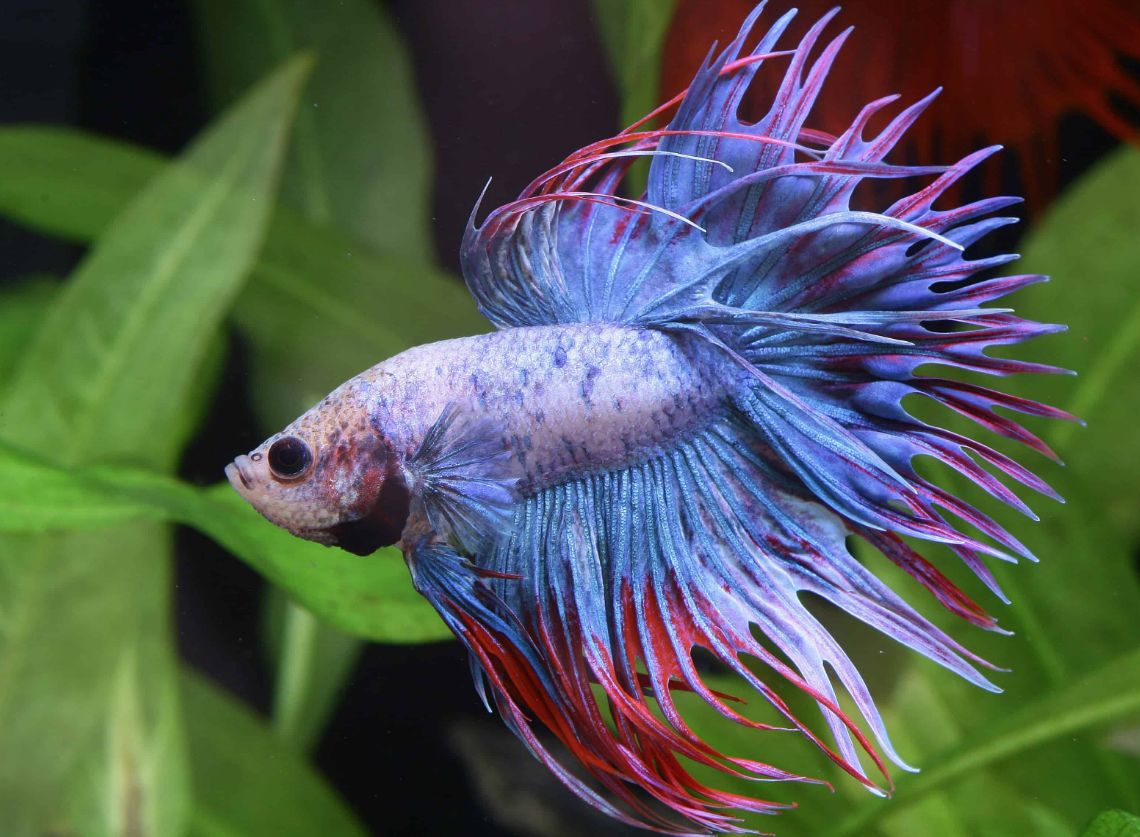
Habitat in the wild
The Betta splendens belongs to the Anabantoidei suborder, known for its unique adaptation that allows it to breathe atmospheric oxygen. This adaptation, called the labyrinth organ, enables bettas to survive in oxygen-depleted environments, such as shallow puddles and rice paddies. By using this organ, bettas can extract air from the surface in addition to the oxygen they get through their gills.
Betta splendens is one of over 70 described species within the Betta genus, though some species remain unclassified. Bettas can be broadly categorized into two groups: those that brood their juveniles in their mouths and those that build bubble nests.
Native to South-East Asia, betta fish are commonly found in Thailand, Cambodia, and Vietnam. Thailand is often recognized as their primary habitat, although the betta’s widespread popularity makes its exact origins a bit elusive.
The name “Betta” is derived from the Javanese term “Wuder Bettah,” while in Asia, the fish is frequently called “pla-kad,” which translates to “biting fish.” In Thailand, the betta is also referred to as “pla kat Khmer,” meaning “biting fish from Khmer lands.” These names highlight the fish’s aggressive nature, especially among males, who are known for their territorial behavior and tendency to engage in combat.
Betta fish are adapted to life in small, confined spaces and are often found in thickly planted, slow-moving waters such as rice paddies, shallow ponds, ditches, and slow-moving streams. Their natural habitats feature dense vegetation, including floating plants, submerged plants, and plant roots, which offer essential hiding spots and protection.
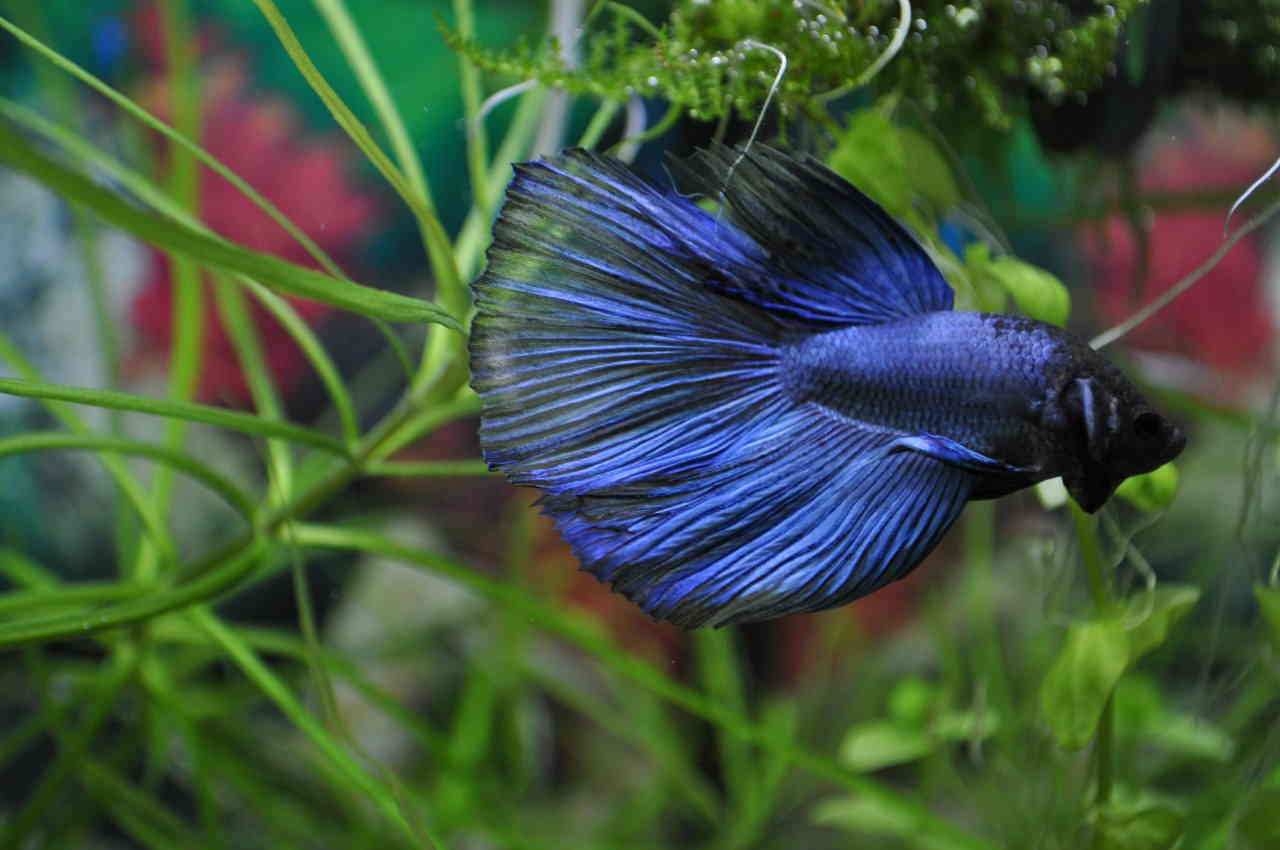
Description
Size
Betta fish typically grow to a size of around 2.5 to 3 inches (6 to 7.5 cm) in length, although there can be some variation among individuals. Males and females generally reach similar sizes, with slight variations depending on genetics, nutrition, and overall health.
It’s important to note that this size refers to the body length of the fish, excluding the length of their fins. The long, flowing fins of fish can extend beyond their body, adding to their overall visual appeal and graceful appearance.
Lifespan
The average lifespan of a Siamese fighting fish, or betta, typically ranges from 2 to 5 years. With attentive care and a well-maintained environment, however, some bettas can live longer, reaching up to 6 years or more.
Body and color
In the wild, the Siamese fighting fish, or betta, is quite plain, sporting an elongated greenish or brownish body with short, rounded fins. However, through selective breeding, today’s bettas have evolved into stunning ornamental fish. Their vibrant colors and dramatic fin shapes make them highly collectible and admired by aquarists worldwide.
Betta fish are renowned for their brilliant and varied colors, which can range from deep reds and blues to vivid greens, yellows, oranges, and even metallic hues. The intensity and combination of these colors can differ significantly among individual fish and their respective varieties.
A hallmark of betta fish is their long, flowing fins. These fins can be delicate and often feature intricate patterns, enhancing their visual appeal. The fin shapes vary widely depending on the betta variety, including veil tail, delta tail, half-moon, crown tail, and double tail. Each type has its unique characteristics, from the gracefully extended veil tail to the dramatic half-moon.
In addition to their stunning appearance, male betta fish use their impressive fins and gill covers to display aggression and assert dominance. When flaring their fins, they create a striking display that makes them appear larger and more formidable, a behavior rooted in their natural territorial instincts.
| Characteristic | Description |
|---|---|
| Scientific Name | Betta splendens |
| Common Names | Betta fish, Siamese fighting fish |
| Size | Typically 2.5 to 3 inches (6 to 7.5 cm) in length |
| Lifespan | 2 to 5 years, with proper care and maintenance |
| Colors | Various vibrant colors including red, blue, green, yellow, and more |
| Fin Types | Veil tail, delta tail, half-moon, crown tail, double tail, and more |
| Temperament | Male bettas are territorial and aggressive, while females are generally less aggressive |
| Habitat | Shallow waters of Southeast Asia, including rice paddies, ditches, and slow-moving streams |
| Water Temperature | 76-82°F (24-28°C) |
| Water Parameters | pH: 6.5-7.5, hardness: 5-20 dGH (slightly acidic to slightly hard water) |
| Feeding | Carnivorous diet, primarily fed high-quality betta pellets or flakes, supplemented with occasional live or frozen foods |
| Tank Size | At least 5-gallon tank is recommended, larger tanks are better for their well-being |
| Tank Setup | Plants (live or artificial), hiding spots, gentle filtration, and proper heating |
| Compatibility | Males are typically kept alone to prevent aggression, while females can sometimes be kept together in larger tanks |
| Special Features | Possess labyrinth organ for breathing air from the surface, males build bubble nests for breeding |
| Common Health Issues | Fin rot, ich, velvet, constipation, and various infections |
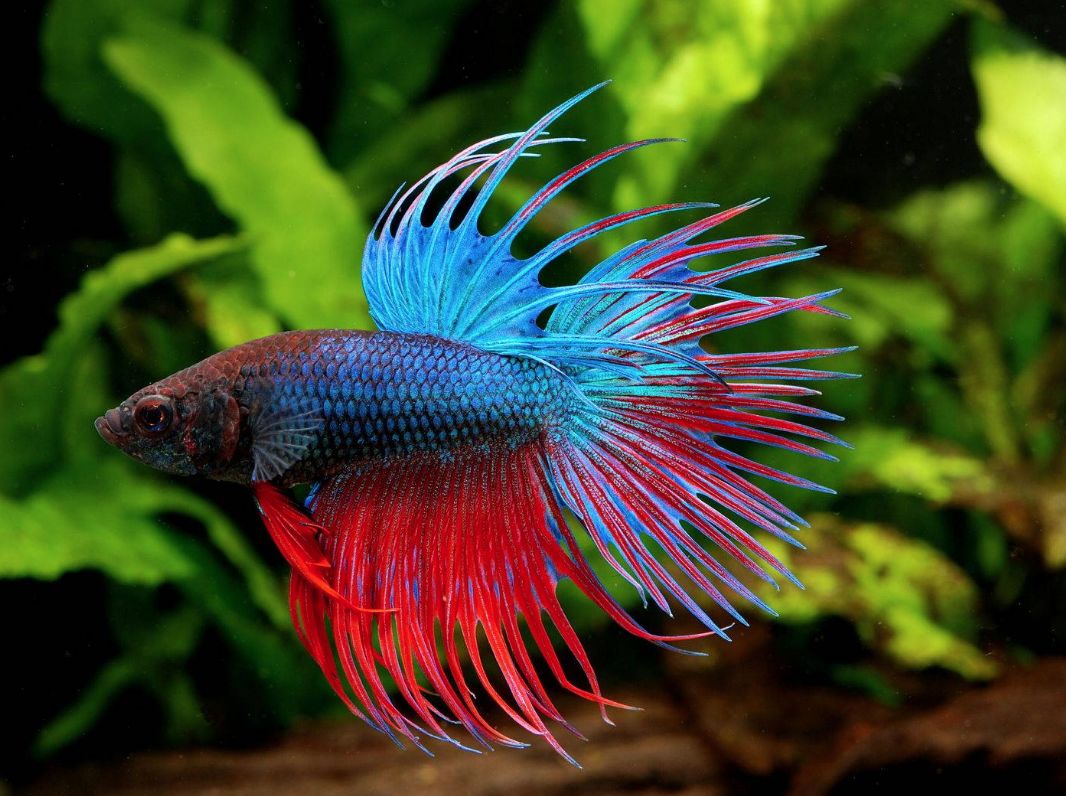
Difficulties in keeping
The Siamese fighting fish is an excellent choice for beginners due to its ease of care and adaptability. Bettas thrive in smaller tanks and can tolerate a range of water conditions, making them ideal for those who may not have the space or resources for larger aquariums. They require minimal space and can thrive with basic care.
Betta splendens is not particular about its diet and will accept nearly all commercially available fish food. Although bettas are often sold as community tank fish, it’s important to remember that male bettas are known for their aggressive behavior, especially towards other males. They may also display aggression towards females and during the spawning period.
While bettas can be kept alone in a tank and do well in solitary conditions, they can also be housed with other fish if carefully chosen. Their labyrinth organ allows them to survive in low-oxygen environments, including small tanks, making them resilient to less-than-ideal conditions.
When keeping bettas with other tank mates, it’s crucial to select companions that are unlikely to provoke them. During the spawning period, males become particularly aggressive and may attack any fish that resembles them or has bright colors, including females of their own kind.
Therefore, it is generally advisable to keep only one male betta per tank, or to provide a spacious setup with plenty of hiding spots if keeping a pair. This allows the female to avoid the male if needed and helps maintain a peaceful environment.
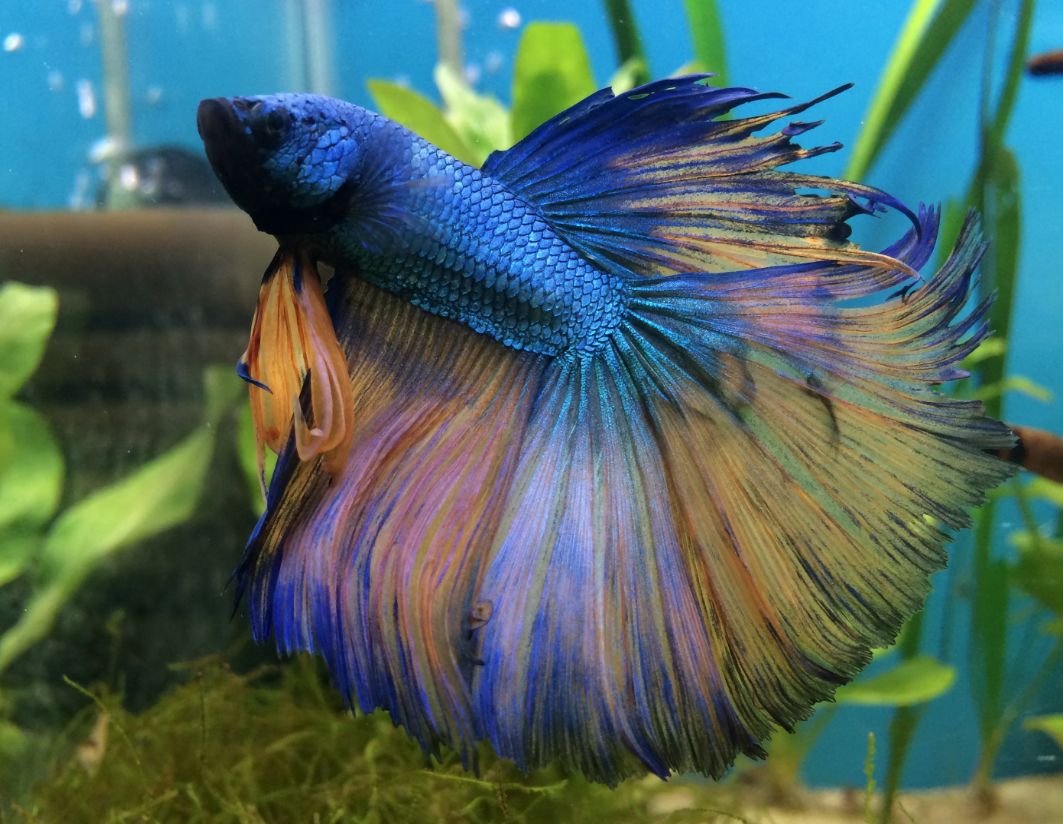
Care and keeping at the tank
Tank size
The minimum recommended tank size for a betta fish is 5 gallons (19 liters). This size provides better water stability, easier maintenance, and ample space for the fish to swim and explore. While bettas are known to swim throughout the water column, they generally prefer the upper layers.
Avoid round-shaped tanks, which are often popular but do not offer the best environment for bettas. Instead, opt for tanks that provide horizontal swimming space, which is more beneficial for the fish’s activity and health. A tank with a heater is advisable to maintain the optimal temperature for bettas, and it should be covered to prevent the fish from jumping out.
If housing bettas with other fish, a larger tank is essential. It should include hiding spots for females, subdued lighting, and floating plants to create a stimulating and enriching environment. These additions help reduce stress, provide resting areas, and simulate the betta’s natural habitat.
Larger tanks are generally preferred, as they offer more swimming space and room for decorations. They also help dilute waste products and maintain a more stable environment, contributing to the overall health and well-being of your betta fish.
Water parameters
- Temperature: Betta fish thrive in water temperatures between 76°F and 82°F (24°C and 28°C). Consistency is key, so use a reliable aquarium heater to maintain a stable temperature within this range.
- pH Level: The ideal pH range for betta fish is slightly acidic to neutral, around 6.5 to 7.5. Regularly monitor the pH using a test kit and make adjustments with pH buffers or conditioners designed for freshwater aquariums to ensure a stable environment.
- Water Hardness: Betta fish can tolerate a range of water hardness, but ideally, the general hardness (GH) should be between 5 to 20 dGH (degrees of general hardness). This range represents slightly soft to moderately hard water, which is suitable for bettas.
- Ammonia and Nitrite: Both ammonia and nitrite are harmful to fish and should be kept at zero. Regularly test these parameters, especially during the initial setup of a new aquarium, and ensure proper biological filtration to establish a healthy nitrogen cycle.
- Nitrate Levels: Nitrate is a byproduct of the nitrogen cycle and should be maintained at a relatively low level, ideally below 40 ppm (parts per million). Performing regular water changes helps keep nitrate levels in check and supports overall water quality.
Routine tank care includes weekly water changes of about 25% of the total tank capacity. Keeping the tank clean is essential, as leftover food and waste can negatively affect the appearance and health of your betta fish’s fins, leading to potential issues if not addressed promptly.
Substrate
Aquarium gravel is a popular substrate choice for betta fish tanks. It comes in various colors and sizes, allowing you to create a visually appealing tank. Fine-grain aquarium sand can also be used as a substrate for betta fish tanks. Sand provides a natural and soft bottom surface.
Some betta fish keepers prefer to have a bare bottom tank, which means having no substrate at all. A bare bottom tank has the advantage of easy cleaning and maintenance, and it allows for good water circulation. However, it may lack the aesthetic appeal of a substrate-filled tank.
Decor
Live or artificial plants can be added to the tank. Live plants, such as Java fern, Anubias, or floating plants like Amazon frogbit, provide hiding spots, oxygenation, and natural aesthetics. Artificial plants offer low-maintenance alternatives and can still provide hiding places and visual interest.
Betta fish appreciate hiding spots to retreat and rest. Decorative caves, tunnels, or coconut shells can serve as hiding places while adding texture and visual appeal to the tank.
Floating logs or specially designed betta hammocks provide resting spots near the water’s surface. These mimic the fish’s natural behavior of resting on plant leaves or other surfaces.
Diet
Diet plays a crucial role in the health and well-being of fish. In the wild, bettas are omnivorous and their diet includes insects, insect larvae, zooplankton, and even some algae. This natural diet helps them thrive in their native environments.
In a tank, betta fish can eat a variety of foods, including live, frozen, and artificial options. To keep your betta healthy and vibrant, it’s important to provide a diversified diet. Feed your betta small portions twice a day. Overfeeding can lead to obesity and associated health issues, so it’s crucial to provide the right amount of food. Monitor your betta’s eating habits and adjust the frequency and portion sizes as needed. It’s generally better to slightly underfeed than to overfeed. Remove any uneaten food after a few minutes to prevent it from polluting the water and compromising water quality.
A staple part of a betta’s diet should be high-quality pellets. These pellets are specially formulated to provide essential nutrients and are designed to float, making them easy for bettas to find and consume.
While betta pellets are an important part of their diet, incorporating variety is beneficial. Occasionally supplement their diet with live or frozen foods such as brine shrimp, daphnia, bloodworms, or other small invertebrates. These additions offer extra nutrients and help mimic the betta’s natural diet, contributing to its overall health and vibrancy.
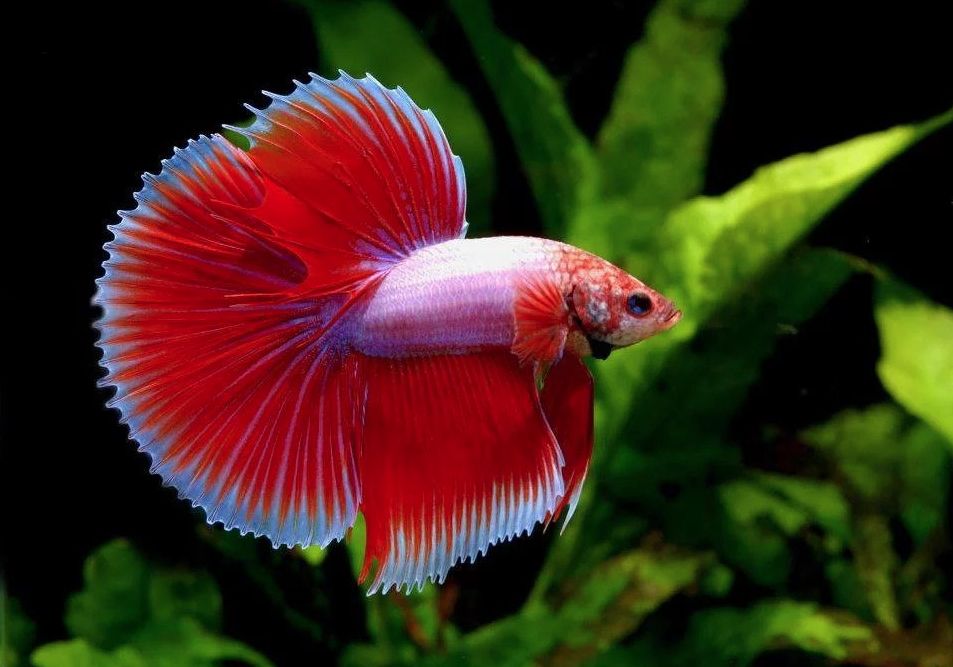
Tank mates
Female Betta Fish: Keeping multiple female together can be successful in a properly sized tank with plenty of hiding spots and ample space. Female bettas can be housed in groups of at least five to create a sorority where aggression is dispersed. However, it’s essential to monitor their behavior closely and be prepared to separate any aggressive individuals to prevent conflict.
Peaceful Community Fish: Some peaceful and non-aggressive fish can make suitable tank mates for bettas. Options include small schooling fish like neon tetras, ember tetras, harlequin rasboras, and celestial pearl danios. Ensure the tank is spacious enough to accommodate all the fish and that the tank mates are not nippy or have long, flowing fins that could provoke aggression in the betta.
Snails: Peaceful snails, such as nerite snails or Malaysian trumpet snails, can be good tank mates for bettas. They help clean up excess food and algae and add visual interest with their shells. Their slow movement and non-threatening nature make them a suitable choice.
Shrimp: Certain shrimp species, like Amano shrimp, can coexist with bettas. However, some bettas might view shrimp as potential prey and may attempt to hunt or nip at them. Monitor the behavior and be ready to remove the shrimp if necessary.
Incompatible Fish: Avoid keeping bettas with fish that are known fin-nippers, such as dwarf puffers or tiger barbs. Bettas may also nip at long-finned fish, so it’s best to avoid species with elaborate fin structures. Generally, if a fish’s appearance or behavior seems to provoke the betta, it’s wise to keep them apart.
Gender differences: male vs female
Distinguishing between male and female bettas is relatively straightforward once you know what to look for. Here’s how you can tell them apart:
Fins and Body Shape: Male are easily recognizable by their long, elaborate fins, which can vary in shape and pattern, creating a dramatic display. These fins are often large and flowing. In contrast, female have shorter, less ornate fins. Additionally, male generally have a slimmer, more streamlined body shape, while females tend to have a rounder and fuller shape, especially when carrying eggs.
Behavioral Traits: Behavior is another clear indicator. Male are known for their territorial and aggressive nature, particularly towards other males. They may exhibit flaring, chasing, and fighting behaviors to establish dominance. Female, however, are usually less aggressive and can often live peacefully with other fish.
Breeding Behavior: During breeding, male display a unique behavior by building bubble nests at the water’s surface. They create these nests using bubbles and saliva to protect their eggs. Female do not participate in nest building, which further distinguishes them from males.
Breeding
As a majority of Anabantoidei kind, the betta fish is a bubble nest builder. Breeding is an easy, but rather a troublesome process due to the male temper and the ill health of juveniles.
To grow the juveniles successfully, one should get prepared for the process. After you’ve chosen a couple of breeders, you should feed them well with live feed and keep the fish separately before they start spawning.
Once the female is ready to spawn, its abdomen becomes more rounded due to the eggs she has inside. As soon as the couple is ready to breed, it’s put into a spawning tank with the water level not higher than 15 cm.
You may encounter some info over the Internet, which says that a tank of 10 liters capacity will do as a spawning tank, however, if you do some calculations, you’ll see that it’s not enough.
Choose the tank capacity according to your resources, you could do with any other tank size, since anyway male will haunt and fight the female and she’ll need a place to hide.
Increase the water temperature up to 26-28 °C, and then the couple will start building a nest. To keep the male from killing the female, add some thickly growing plants into the tank (for example, some Java moss and keep in mind that 10 liters capacity isn’t enough).
Put some floating plants on the water surface – water lettuce or amazon frogbit.
As soon as the nest is ready, the male will start calling the female to get closer to it. Then the female will close its fins and approach to the male, but keep an eye on the male so he wouldn’t kill her!
The male embraces the female one squeezing the eggs out of her, and simultaneously sperm is being released. Female lays about 40 eggs in a time and about 200 eggs in general during the whole spawning period. The eggs go down to the tank bottom, and the male picks them up and puts into the nest.
The female can also help him with that, but more often she just eats the eggs, so it’s better to remove the female from the spawning tank right after the spawning is finished.
The eggs hatch in 24-36 hours. Larva stays in the nest for 2 or 3 days after that, until it completely eats its yolk sack and starts to swim.
Once juveniles start to swim, you’d better remove the male from the tank, because it may start eating the juveniles. You should lower the water level (up to 5-7 cm) and turn on the aeration at a minimal level.
These should be done till the juveniles have their labyrinth organ completely developed, and they start taking some air from the water surface. After that, you may start to raise the water level gradually. All the abovementioned happens in about 4-6 weeks after the spawning.
Feed betta juveniles with infusorian, egg yolk. As the juveniles grow, you may add some brine shrimp nauplii and tubifex into their diet. Juvenile’s rate of growth is quite individual and different, so you should sort them according to their size to avoid cannibalism among them and to prevent their fights in the future.